Menu

Around the world, agriculture uses the most fresh water. This shows how much impact farming has on our environment. Thanks to technology, farming has advanced. Now, tools like drones, robots, and sensors help farmers meet environmental rules.
In New Zealand, over 49,530 farms needed to have their water use checked in 2021. This shows the urgent need for greener solutions.
Farms today use high-tech tools like sensors, aerial images, and GPS. These help in precision farming. This means farmers can use water, fertilisers, and pesticides more wisely. They use only what’s needed. This is better for nature.
With the world needing more food but still wanting to protect the environment, these tools are key. They help in making sure we can grow food in a safe and sustainable way.
Modern agriculture relies heavily on technology to grow better and protect the planet. By using advanced tools, farmers can produce more food efficiently. This approach supports the increasing global food need while being kind to the earth.
New technologies in agriculture are improving how we grow crops. Systems like Farm Management Information Systems (FMIS) give farmers key information. This helps them decide when to plant, how to water efficiently, and what to grow where.
Precision Agriculture (PA) uses sensors and tools to track soil, weather, and crop health. This technology fine-tunes farming, boosting harvests.
| Technology | Function | Impact |
|---|---|---|
| Farm Management Information System (FMIS) | Analyzes data for informed decision-making | Enhanced productivity and resource management |
| Precision Agriculture (PA) | Utilizes sensors and analytical tools | Improved crop yields and resource efficiency |
| Agricultural Automation and Robotics | Reduces manual labor using robotics | Increased efficiency and reduced labor costs |
| Drones | Monitors crops and applies chemicals | Increased efficiency and reduced water waste |
Technology is making farming greener. Automated and sensor-based irrigation cuts water use and saves money while boosting crops. Drones and robots reduce the need for people, making farming more efficient and less harmful to the environment.
Using smart technology in agriculture promotes sustainable practices. It trims water, fertiliser, and pesticide use, which helps the planet. These smart tools improve productivity and support a healthier world.
The world of agriculture is changing. Now, advanced sensors and smart devices are making farming smarter and kinder to the planet. These tools help farmers use resources better and look after their land well.
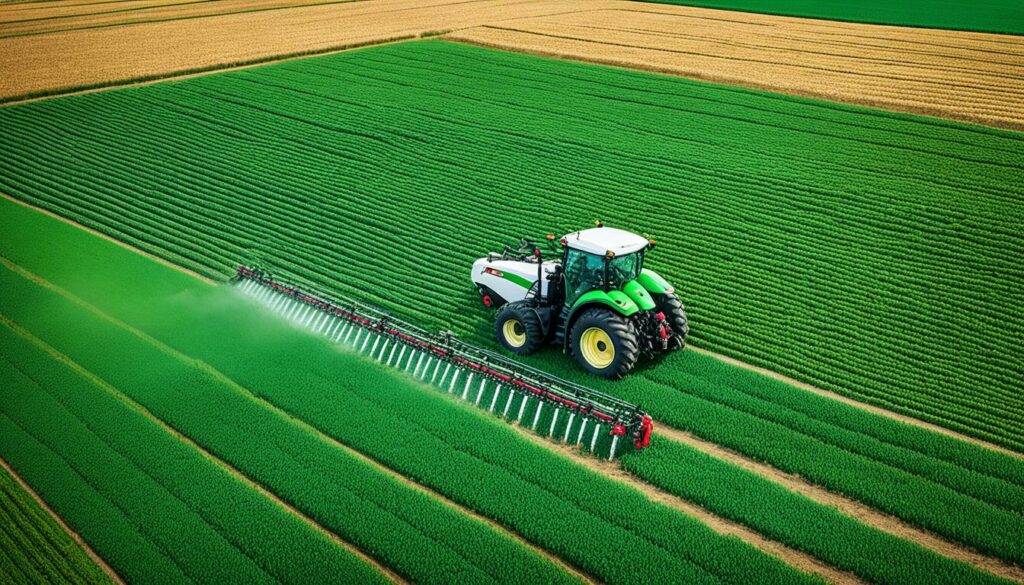
Many sensors are used in farming to keep an eye on crops. These sensors can check the temperature, the moisture in the soil, and even measure force. For example, drones help in farming by spraying crops and spotting weeds from above. This saves time and makes farming more efficient.
Smart devices and high-tech tools are changing how we keep an eye on crops. They use artificial intelligence to check on the plants and the soil quickly and accurately. This helps farmers make better choices and use their resources just right.
It’s a big market that’s set to be worth $43.4 billion by 2025. These technologies are helping farmers grow more food and make sure it’s safe to eat. They’re also saving money and helping the environment. This is part of working towards a greener way of farming.
Farmers need this new tech to keep up with the growing demand for food. But, they also want to protect the planet. Innovations like those found with Agtech show a way forward. They help farmers meet their goals without harming the earth.
Precision agriculture is changing the face of farming with its focus on individual plants. It uses high-tech methods to treat tiny areas. This changes how farming is done, making it more efficient and eco-friendly.
This method boosts crop yields by managing each area of a field differently. It lets farmers use resources better, cutting down on waste. This means they can grow more food while protecting the environment.
Using up-to-the-minute data about crops and soil is a big part of precision agriculture. It helps farmers make quick, smart choices. This leads to better farming and less harm to the environment.
But, there are some challenges. Dealing with all the data can be overwhelming. Plus, the tools used need trained people to handle them. And there are rules that farmers must follow, which can make using certain technologies hard.
Still, precision agriculture brings big benefits. It cuts down on harmful emissions and helps the earth absorb more CO2. It’s key in making sure we can feed everyone in the future without hurting the planet.
| Benefit | Impact |
|---|---|
| Increased Crop Yields | Maximises resource utilisation, minimises waste. |
| Cost Reduction | Efficient use of water, fertiliser, and pesticides. |
| Improved Efficiency | Real-time data facilitates better decision-making. |
| Environmental Sustainability | Reduces environmental impact by minimising resource use. |
Robotics are changing farming as we know it. They are a key part of meeting future needs in agriculture. They don’t just take over jobs people do. They improve how accurate and efficient farming can be, helping the environment too.

By 2050, our planet will need to produce a lot more food for almost 10 billion people. But, not enough people are choosing to work in farming. This has led to challenges, with more farmers picking crops that need less human work. Thanks to robots, tasks like planting, weeding, and gathering crops don’t need as much human effort. Big companies and groups like Agrobot and Abundant Robotics are making robots that gently pick fruits and vegetables. This cuts down on the hard work people have to do and saves money.
Robots in farming don’t just mean fewer people working the fields. They help make farming more precise and efficient. For example, Blue River Technology uses special eyes and robots to very accurately put weed killers on fields. This way, they kill weeds that have grown stronger against regular weed killers. But, they use a lot less weed killer, up to 90% less. Then there’s a service from American Robotics that uses flying drones and smart computers to give farmers useful information. This helps farmers do their job better, uses resources smarter, and is kinder to the planet.
| Robotic Applications | Benefits |
|---|---|
| Planting and Seeding | Increased Precision |
| Weeding | Reduced Herbicide Use |
| Harvesting | Lower Labor Costs |
| Milking | Consistency and Efficiency |
| Livestock Management | Enhanced Data Collection |
| Greenhouse Operations | Energy and Water Conservation |
| Autonomous Drones | Improved Field Monitoring |
Farming with robots and smart technology is making agriculture better and more eco-friendly. These new ways are changing how farms work for the better. They ensure we have enough food and take care of our planet at the same time.
In modern agriculture, GPS technology in agriculture is now a core part of monitoring and planning. It brings together sensors, data analysis, and maps to help with farm monitoring systems. By making sure resources are used best, it boosts crop growth and makes farms more profitable.
Remote sensing is also key. It gives detailed info on things like soil wetness and how healthy crops are. This data is combined with what satellites and sensors pick up in real time. Together, they give a deep look at what’s happening on a farm. This allows for smarter choices and cuts down on wasted resources.
There are also tools for farming with more precision. These use GPS technology to meet the exact needs of different parts of a field. For example, Variable Rate Technology (VRT) lets farmers apply things like fertilisers at exact rates based on what each part of a field needs. This precision not only makes farming more efficient but also reduces harm to the environment.
Now, we have drones that fly over fields, carrying GPS and sensors. They get clear pictures of the condition of crops and soil from above. These UAVs can quickly cover a lot of land. Farmers get to see real-time details, spotting problems like lack of water or bugs right away. With this info, farmers can act quickly and apply solutions that are exactly what their crops need.
These advances show how important technologies like GIS (Geographic Information Systems) are for planning in agriculture. By using GPS data with maps, GIS helps farmers use resources better and cut down on waste. The teamwork of GPS and GIS boosts farm profits and makes farming kinder to the environment.
| Technology | Function | Benefits |
|---|---|---|
| GPS | Real-time data on location and conditions | Optimises resource use, reduces waste |
| GIS | Combines GPS data with maps | Enhances decision-making, improves yields |
| VRT | Variable Rate Technology | Increases efficiency, reduces input use |
| Drones | High-resolution imaging, real-time data | Targets crop management strategies |
Adding temperature and moisture sensors in agriculture has changed how farmers work. Soil temperature sensors keep track of ground temperature in real-time. This information is vital for many farming tasks like looking after greenhouse plants, field crop irrigation, disease control, and planning crops by season.
Meanwhile, soil moisture sensors tell us how soil moisture changes over time. They’re very accurate at spotting water stress in plants. This helps in setting up just the right amounts of irrigation and guessing how much water crops need. With these sensors, farmers can water more efficiently. This leads to healthier plants and less water waste.
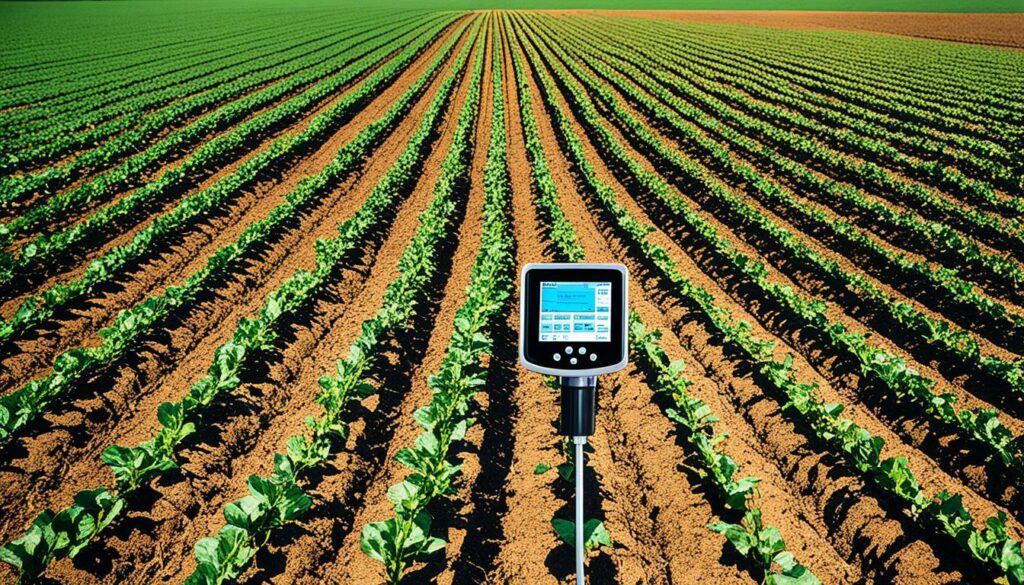
Using information from both types of sensors wisely can boost harvests and cut down on waste. By closely managing soil temperature and moisture, farmers can better adapt their methods to support plant growth. These tech tools in agriculture are key to using resources wisely and farming in a way that protects the environment.
93% of food makers say it’s vital to keep the right temperature and humidity to stop things like spoilage, illness, and waste. In farming and gardening, almost all crop harvests count on keeping the surroundings just right with smart sensors.
Around 85% of businesses now use online platforms for keeping an eye on temperature and humidity. They like that it’s automatic and saves money. This shows smart farming tools, like these sensors, are becoming essential for farming smarter.
The impact of temperature and moisture sensors in farming is huge. They bring a lot of advantages that lead to more accurate and smart farming. This helps push forward smart farming technologies.
In the last ten years, the way we farm has changed a lot thanks to drone technology. Drones in agriculture let us check on crops in new ways. They help us use water and fertilisers better while tracking plant health. Let’s see why drones and aerial images are now key in farming.
With aerial imaging, we can watch over crops in detail. Drones take pictures from above, showing us which plants might be struggling. These images help spot problems like bugs, lack of nutrients, or too little water. Fixing these early boosts plant growth and protects harvests.
Using drones also helps us be smarter about water, fertilisers, and pesticides. By flying over fields and scanning them, drones give vital information. This helps farmers know exactly where and when to use these resources. It’s an important step towards farming in ways that don’t harm the planet.
To enjoy these drone benefits, farmers need to know how to use them well and follow rules. In the United States, drone pilots must pass a special test to fly them commercially. This makes sure drone use is safe and brings the most benefits to farming.
| Aspect | Benefit | Requirement |
|---|---|---|
| Monitoring | Enhanced crop health monitoring | High-resolution aerial imagery |
| Resource Use | Optimised application of water and fertilisers | Data analysis from UAV sensors |
| Regulation | Improved operational safety and compliance | Remote Pilot Certificate |
Advances in farming technology play a big role in meeting strict environmental compliance standards. Many areas struggle due to a lack of proper controls for overflow management. But, new technology can help tackle these issues head-on.
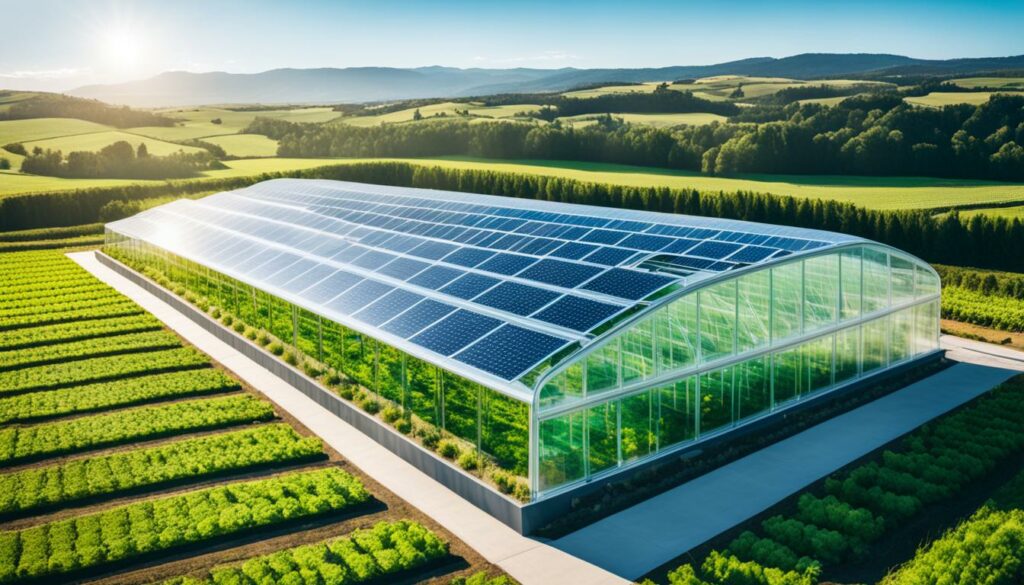
Recent studies show that a large number of big facilities haven’t followed Clean Water Act rules in eight years. This failure highlights the critical need for innovation in agricultural technology. By improving checks and balances, technology aids in keeping up with rules, even when human inspections decrease.
Using machine learning at these sites has proven quite successful. It can find twice as many rule breaks in facilities without needing more human effort. Also, deep learning finds about 95% of pollution sources with just a fraction of the standard resources. This is especially true for spotting agricultural waste.
| Country | Compliance Improvement |
|---|---|
| Uruguay | Increased tax payments by 6.4% |
| Norway | Reduced hazardous waste violations by 15 to 23 percentage points |
| Colorado | Compliance rates increased from 32% to 84% |
Putting compliance technology in place isn’t just about following the rules. It’s also about pushing for eco-friendly farming. By sharing insights and tailor-made advice, regulators help farms do better in following the law. This assistance promotes both environmental care and efficient compliance.
Using sustainable ways in farming is key for a good mix of making money, being fair, and keeping the planet safe. The world will want 35–56% more food by 2050, making smart farming without many chemicals very important.
A big step is to use less pesticides and better fertilisers. These methods keep the soil healthy, save water, and lower pollution. Choosing small, reasonable changes lets farmers help the planet and keep their farms going strong.
Farmers are cutting back on chemicals by using smart tools. These tools only spray and feed plants where it’s needed, which means less harm to the environment. Foods grown this way attract people and shops that care about being green and fair.
Many fields, from biology to economics, work together to find new ways to use nutrients from waste. They’re looking into using things like biochar and wastewater to make farms more sustainable.
Using water wisely in farming is a must. Using better ways to water, growing plants that need less water, and looking after crops well can cut the water used. This helps farms survive dry times and fights water pollution.
Sustainable farming is good for business and the earth. With less phosphate to use in 50–100 years, saving water and cutting back on chemicals is more important than ever.
| Main Objectives | Current Practices | Future Outlook |
|---|---|---|
| Healthy Environment | Minimising chemical inputs, promoting soil health | Advanced nutrient recovery, efficient water use |
| Economic Profitability | Targeted fertiliser and pesticide application | Enhanced crop management systems |
| Social Equity | Promoting farmworker wellbeing, reducing pollution | Values-based foods, innovative agricultural techniques |
Advanced technology greatly helps in resource management in agriculture. It lets farmers better handle water, soil nutrients, and energy. This is key for keeping our resources sustainable.
Sophisticated farming management technology helps farms use resources better. This reduces harm to the environment. An example is the lower water use in vertical farms compared to traditional ones.
These days, the precision agriculture market is growing. It’s set to hit $43.4 billion by 2025. This shows how much we rely on tech for better farm results and saving resources.
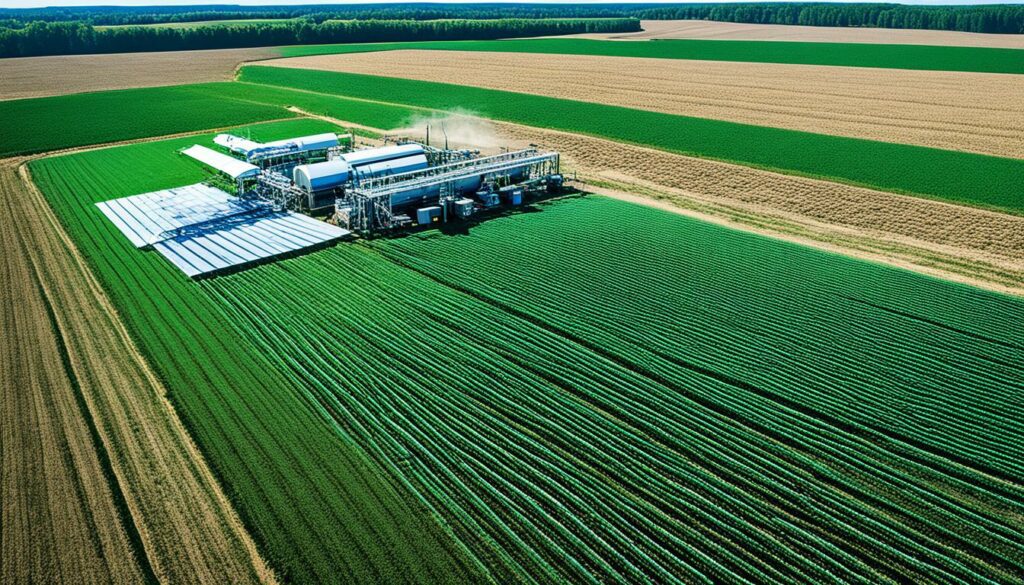
Blockchain and similar tech are also big in food, preventing fraud and ensuring safety. They help meet rules and market needs, and they’re from upstarts in agtech. Platforms like Plug and Play’s Agtech boost them with support and investment chances.
“CIBO Technologies’ recognition by TIME as a top GreenTech Company in 2024 shows its leadership in green farming. It highlights new funding that could change how we farm.” – World Agri-Tech Innovation Summit
CIBO Technologies is ahead in helping agriculture renew itself. It offers ways for farms to get help with sustainable practices. This makes it easier for farmers to do right by the environment.
| Technological Advancement | tBenefits |
|---|---|
| Vertical Farming | tUp to 70% less water usage than traditional farms |
| Blockchain Applications | tSolves food fraud, safety recalls, and traceability issues |
| Precision Agriculture | tMarket predicted to reach $43.4 billion by 2025 |
| Agtech Innovation Platform | tSupport from Plug and Play for business development and investment opportunities |
CIBO uses remote technology and AI to check farming practices from afar. This tech is great for checking emissions, cutting them down, and reporting voluntarily.
Its analysis tools also help look at how new practices affect the planet. This focus on better farming methods supports a cleaner, more sustainable future.
Green technology helps make agriculture more sustainable. It uses eco-friendly methods and renewable energy. This tech is key in creating farming models that protect our planet and are good for business.
Using eco-friendly tech in farming lessens harm to the environment. For instance, 3D printing creates new opportunities and supports growth in various ways. These efforts are vital for meeting green goals and improving how we invest in such technologies.
Adopting renewable energy is crucial in making agriculture more sustainable. Things like solar panels and wind turbines are now standard in farming. They not only fight climate change but also bring good financial returns.
Green farming tech is all about achieving a balance. Big companies, like Apple and Microsoft, are leading the way in using green energy. They set a great example for others and help move the farming sector towards greener practices.
These steps are supported by big investors who want to see more done to tackle climate change. They show that green tech in farming is a must for a sustainable future.
| Company | Green Initiatives | Goals |
|---|---|---|
| Apple | Carbon-free energy consumption | 2030 |
| Microsoft | Removal of 2.5 million mtCO2 | 2021-2022 |
So, embracing eco-friendly farming technologies and clean energy solutions is essential. Progress in green tech helps us protect the Earth while ensuring farms remain productive.
In today’s farming world, following environmental rules is key. Thanks to technology, farmers can stick to strict environmental regulations and still do well. Acts like the Clean Air Act (CAA) and the Food Safety Modernization Act (FSMA) show why we need careful ways to follow agriculture law.

Governments help by pushing tech to meet eco-standards in farming. The Clean Water Act, for example, works on stopping farm pollution from getting into water. The FSMA makes sure our food is safe, reducing sickness with strict cleaning rules. This highlights how using tech for rules can make food safer.
Here’s a look at key environmental rules:
| Regulation | Year Enacted | Focus | Impact on Agriculture |
|---|---|---|---|
| Clean Water Act (CWA) | 1972 | Pollutant discharges into U.S. waters | Limits water pollution from agricultural runoff |
| Food Safety Modernization Act (FSMA) | 2011 | Preventing foodborne illnesses | Ensures product safety and contamination prevention |
| Clean Air Act (CAA) | 1970, amended 1990 | Regulating air emissions | Impacts farmers in regions with air quality standards, like California |
Technology is key for following these laws. Automating and monitoring make it easier and less likely to break rules. Using these techs lets farmers meet standards and be creative. For example, tech helps in better crop planning, benefiting farms and the environment alike.
To follow laws well, farmers must know all the rules, from the federal to the state level. The push to tackle climate change has made rules even tighter. But with smart devices, farms can stay green, follow rules, and do well. So, tech and rules work together, making farms friendlier to our planet.
Advanced agricultural systems are changing farm management for the better. They focus heavily on being sustainable. These systems bring together eco-friendly farm practices with smart farming methods. This helps farms work better, cost less, and be kinder to the planet.
Integrated farm systems are key for looking after farms in a sustainable way. They take various tech tools and put them all in one place. This makes farming smoother and helps to use resources wisely. For example, using CIBO Technologies’ system, farmers get quick help with matching projects, checking if they’re right for them, and signing up easily.
Data-driven farming is now fundamental to agriculture. It lets farmers make choices based on solid information to grow more food and look after the land better. Places like CIBO Technologies use smart technology and cameras to check farming from afar. This means they can make sure farmers are doing their bit for the environment even when they’re not around. They can also work out how much greenhouse gas farms make. This helps meet targets for cutting down on pollution.
| Statistics | Data |
|---|---|
| USDA RCPP Funding Boost | $1.5 Billion |
| Total Program Funding | $80,000,000 |
| Percent of Applications Funded | 15% |
| Range of Awards | $50,000 – $10,000,000 |
| Recognition | TIME Top GreenTech Companies 2024 |
Technological advances in farming are making the work safer. New machinery and smart tools protect workers from old dangers. They make farming safer through modern farming methods backed by the latest tech.
New tech focuses on making manual work less risky. Agricultural robots and automation cut the need for people to work with dangerous machines. This boosts the safety of those working in the fields.
“Compliance rates increased from 32 to 84 percent over three years when small hazardous waste generators completed compliance self-certification in Colorado.”
Precision tools are key to farm safety too. They let farmers keep a closer eye on the soil, plants, and how machines are used. This helps prevent accidents, keeping farms both safe and efficient.
| Safety Benefit | Percentage Increase |
|---|---|
| Compliance rates with safety standards | 52% |
| Detection of violations through machine learning | 100% |
| Lower hazardous waste violations | 15-23% |
Also, using machine learning makes safety checks better. It spots more problems without extra checks. This makes working on farms safer and smarter.
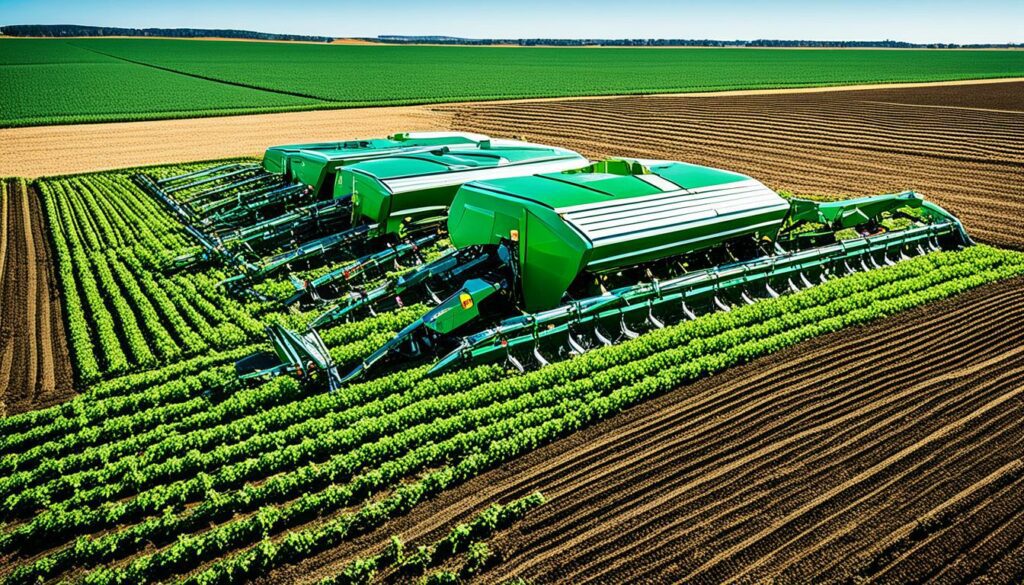
To sum up, tech is improving both safety and the environment on farms. This helps farming stay sustainable and keeps the farm hands safe. It’s key for farming’s future success.
Technology is key to keeping agriculture in line with environmental demands. It offers solutions for the many rules that farmers must follow. These tools fit into farming life and help with environmental compliance.
In farming, laws like the RCRA and CWA demand strict attention. Tools like GPS, drones, and smart sensors are vital. They help farmers watch emissions, handle waste, and look after water quality.
Some cases show how well technology can work for environmental rules in farming:
These successes prove tech in farming works. It makes following rules easier and less harmful to nature. The farming industry does its part for the environment while getting better and greener.
The future of farming looks exciting, with new tech changing everything. We’re seeing more and more innovations that aim to make farming better for the planet and more productive. These new technologies will help farmers work in ways that are good for both nature and their crops.
Technology is quickly changing how we farm. For example, vertical farms use much less water than traditional fields. The Internet of Things, AI, and drones will change how we grow our crops. Platforms like Plug and Play’s Agtech are also helping new ideas grow.
This new tech is making farming way more efficient. It’s attracting younger farmers who are eager to use new, smart solutions. By 2025, the value of high-tech farming could be worth $43.4 billion.
The benefits of high-tech farming will go far beyond just more veggies. These methods will help save water and make our food safer. They will also help the planet deal with climate change.
But, we must tackle issues like who owns the data and lost jobs. We need smart rules and support to balance these challenges. With our world’s population growing fast, we must use new farming tech wisely to feed everyone without harming our planet.
| Technology | Potential Benefit |
|---|---|
| Vertical Farms | Up to 70% less water usage |
| AI-powered Predictive Analytics | Optimises sowing and harvesting times |
| Precision Drones | Accurate pesticide application |
| Smart Greenhouses | Promote sustainable practices |
The world of farming has changed a lot recently. This change is because of new technology. In the last ten years, ideas like yield mapping have become real tools. These tools help make farming better and smarter.
But not everyone uses these new technologies the same way. Some are quick to try them, while others take their time. Today, getting more farmers to use these new tools is the big challenge. Showing that they can save money and help the environment is key.
GIS technology keeps becoming more important. It’s used in farming for many reasons, like learning, money, and saving the planet. The USDA says projects like the Farm Bill have been worth a lot of money. This shows how important it is to follow the rules about the environment.
So, the future of farming is about using smart technology. This technology should help the environment and make money. With the right tools and government support, farming can grow in a way that’s good for everyone. Good farming isn’t just a hope. It’s becoming a real possibility with new technology and good plans.
Technology uses advanced devices in farming to follow environmental rules. It includes tools for sustainable agriculture. These let farmers use resources precisely, causing less harm to the environment.
Technology makes farming more productive and efficient today. It also helps the environment and pushes for new farming methods. These advances lead to better, sustainable ways of farming.
In farming, sensors for temperature and moisture are key. They are used in smart farming. These sensors help check crops, manage them, and make farming more efficient.
Precision farming aims to improve farming in specific places using high tech. This method uses smart tools. It makes using resources more exact, leading to better crops and a healthier planet.
Robots cut down on manual work on farms and make jobs more precise. This cuts down on costs, makes jobs safer, and helps the environment.
GPS is big for watching and planning farms. It’s great for using resources right and making farming work better.
Sensors for temperature and moisture help make smart choices in farming. They boost crops, make managing resources easier, and help keep farming sustainable.
Aerial imaging and drones change farming by watching crop health from above. They use resources better and lower damage to the environment.
Specially made tech helps farmers follow green rules and use the land safely. It backs up keeping the planet healthy and the farm running well.
Using less pesticide, fertiliser, and water is critical to farm in a more eco way. Good technology can make these green practices easier.
Tech has tools for managing water, soil nutrients, and energy wisely. These help farms be more efficient and kind to the planet.
Green tech and renewable energy make farm life friendlier to the planet and farmers’ wallets. They are the way forward for a lasting, productive farm system.
Tech ensures farms meet green laws by keeping a close eye on farming and managing carefully. It’s the hi-tech way of doing things right for the earth.
Using smart farm systems and data for decisions helps farms stay green. These systems cut costs, improve work, and do less harm to the planet.
New tech takes on risky jobs, making work safer and more reliable for everyone on the farm. It’s a better way to do farming work.
Technology makes farming better for the planet by introducing new ways to farm. It shows clear success in keeping farms fruitful and safe.
Later on, we’ll trust on tech even more to farm better. New tech will make farming greener and more productive for the long run. It’s key for the future of farming.